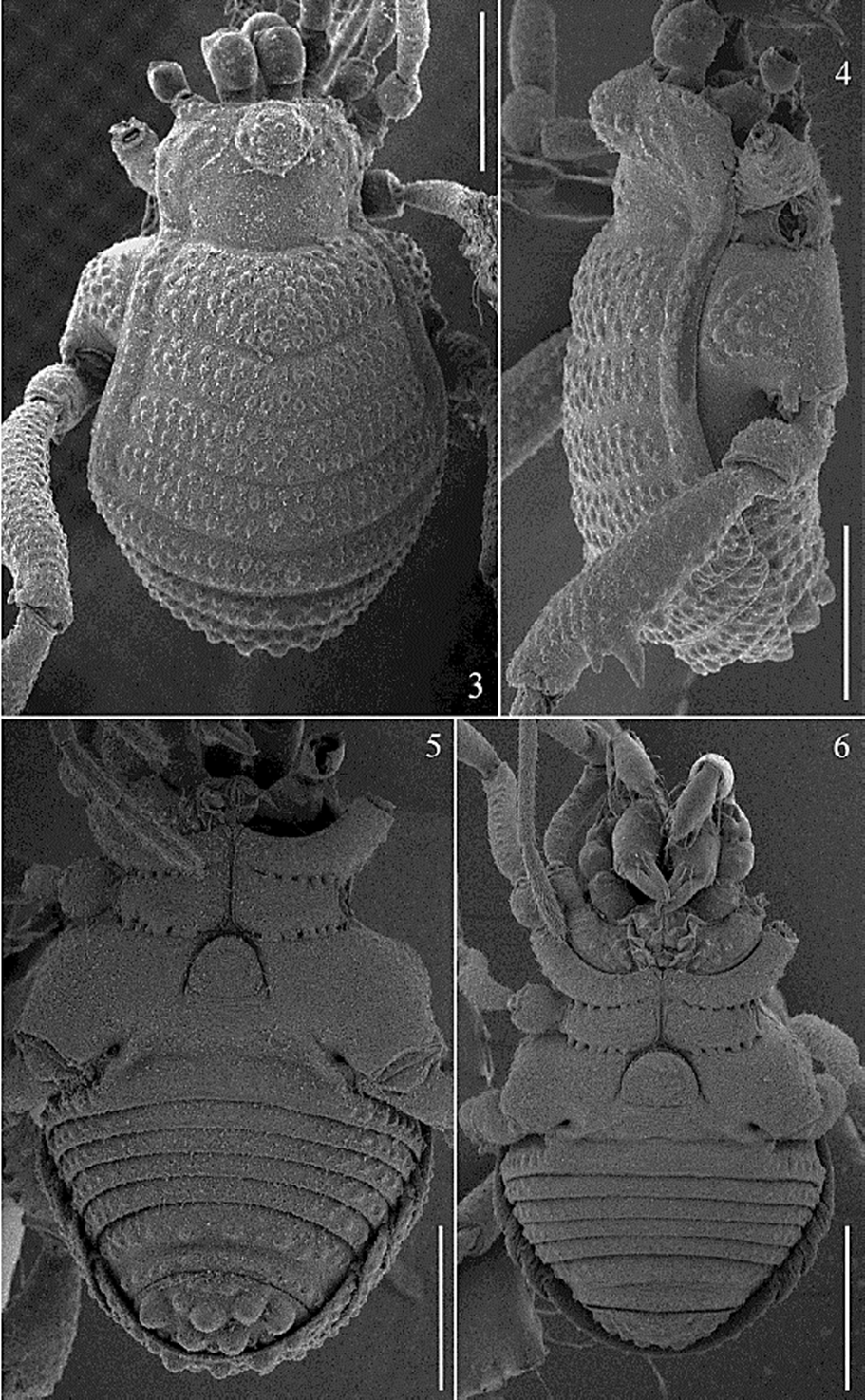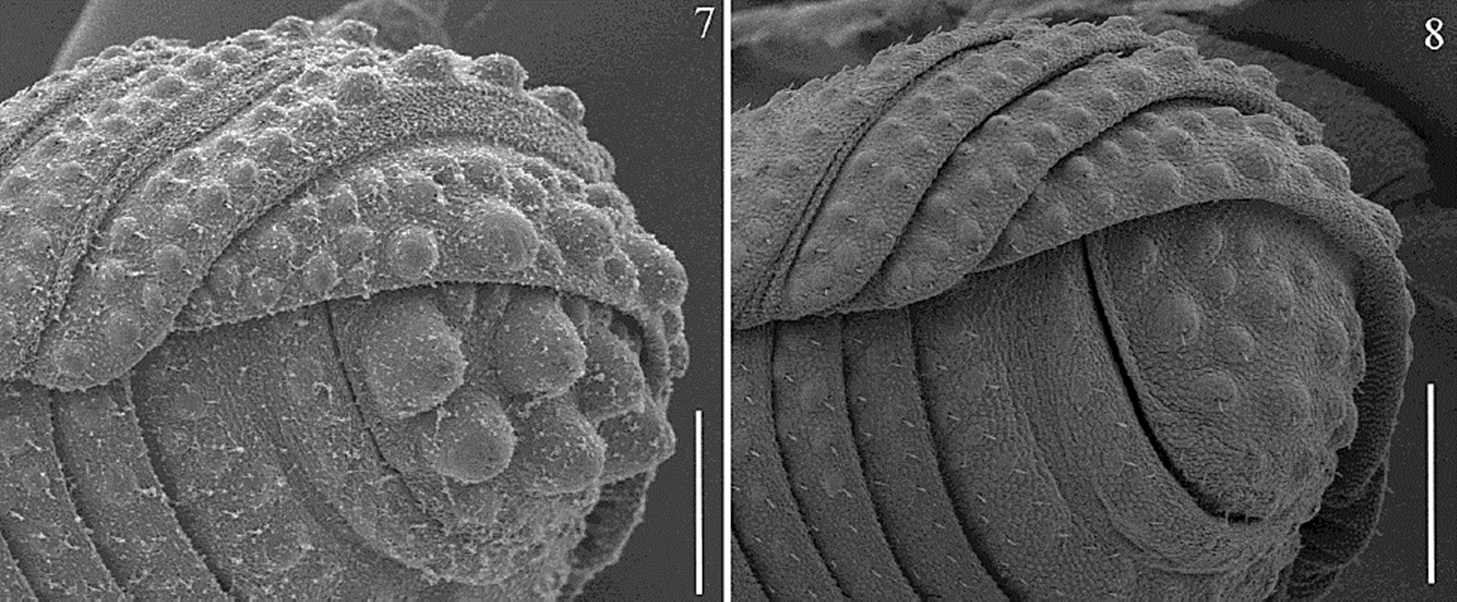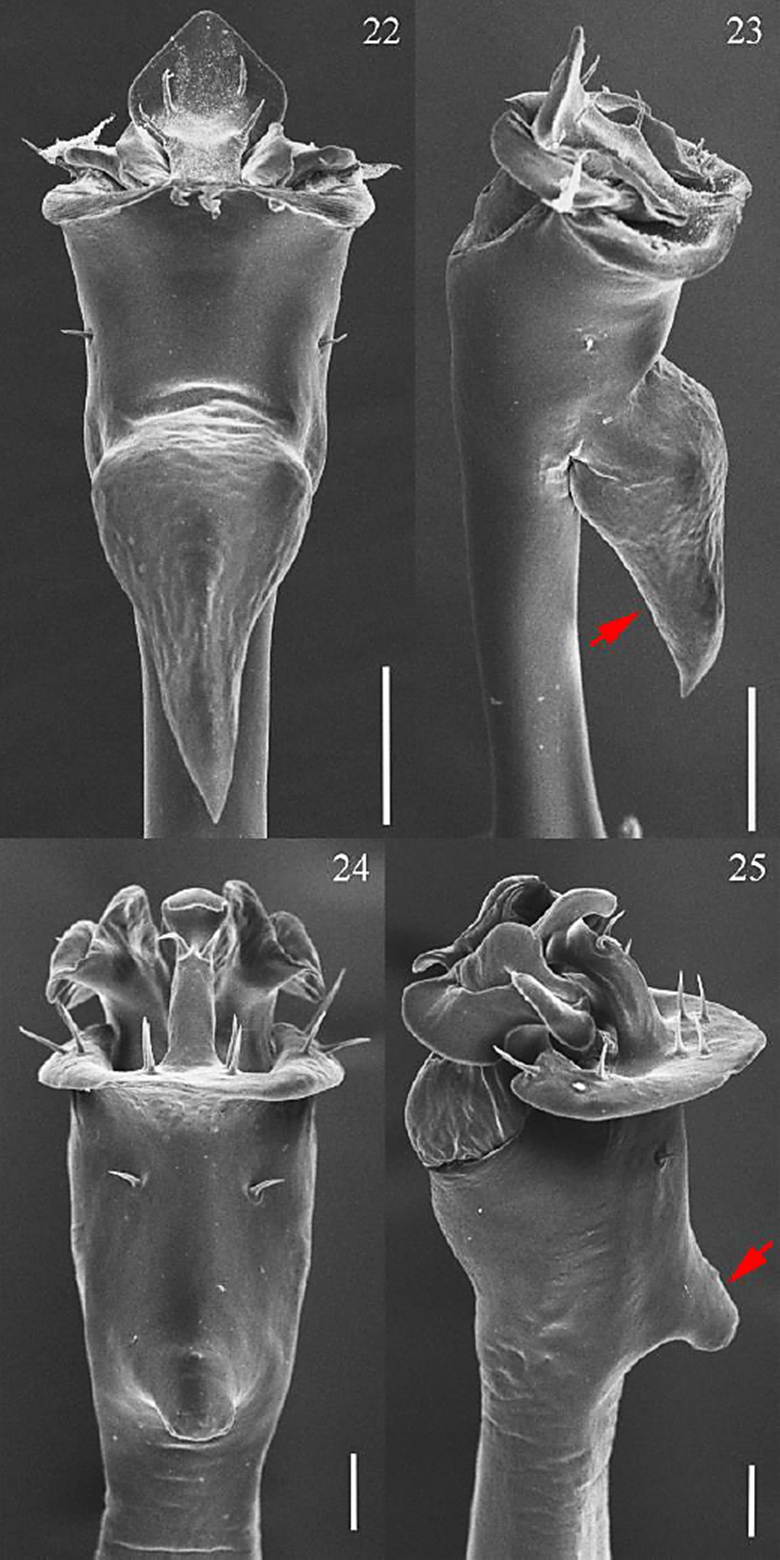INTRODUCTION
The family Zalmoxidae Sørensen, 1886 is the most diverse family of Zalmoxoidea with 61 genera and 226 described species (Kury et al., 2015; Kury & Pérez-González, 2015; Pérez-González et al., 2016; 2017). This family has a peculiar disjunct geographical distribution, being found in the Neo- and Paleotropics, due to ancient transoceanic dispersal from the Neotropics of the Indo-Pacific region (Sharma & Giribet, 2012). The fauna of Asian zalmoxids comprises only the genus Zalmoxis Sørensen, 1886 with 66 species, the remaining members of the family are distributed in tropical America, especially northern South America (Kury, 2003; Sharma et al., 2011; Kury et al., 2015; Kury & Pérez-González, 2015).
The southeast Mexico is the northern limit of the geographical distribution of the family in the Americas, with only four species reported in the country: Ethobunus acanthotibialis (Goodnight & Goodnight, 1953), Ethobunus pilosus (Goodnight & Goodnight, 1953), Pachylicus acutus (Goodnight & Goodnight, 1942) and Pyropharynx gracilis (Pickard-Cambridge, 1905). Whereas E. pilosus and P. gracilis were recorded from few localities including the type locality, E. acanthotibialis and P. acutus were recorded from several localities in Mexico, Belize, and Guatemala (Kury, 2003). Also, Pyropharynx Kury & Alonso-Zarazaga, 2011 is a monotypic genus only known from the type locality, whereas Ethobunus Chamberlin, 1925 and Pachylicus Roewer, 1923 are two of the most speciose genera with 33 and nine species, respectively (Kury, 2003; Pérez-González et al., 2016). In addition, Ethobunus and Pachylicus have long and conflictive taxonomic histories, which involve many generic synonymies proposed without justification by Goodnight and Goodnight (1953).
As a result of several expeditions collecting arachnids in southeastern Mexico, specimens of Ethobunus oaxacensis sp. nov. were found in a low deciduous forest near to the coastal area in the state of Oaxaca. To corroborate its taxonomic status, the types of the other two Ethobunus species reported from Mexico were examined at the American Museum of Natural History (AMNH), NY, USA. Complementing the comparative diagnosis, available literature shows that E. oaxacensis sp. nov. is most similar to Ethobunus cubensis (Šilhavý, 1979) and Ethobunus kratochvili (Šilhavý, 1979), both from Cuba. Final remarks on the taxonomic status of Mexican Ethobunus and Pachylicus are provided.
MATERIALS AND METHODS
Types of E. acanthotibialis and E. pilosus were reviewed at the American Museum of Natural History (AMNH), NY, USA. Types of E. oaxacensis sp. nov. are deposited at the Colección Nacional de Arácnidos (CNAN), Universidad Nacional Autónoma de México (UNAM), Mexico. Additionally, male genitalia of P. acutus (topotypes) and E. aff. acanthotibialis from Mexico: Veracruz: Los Tuxtlas were examined for comparisons. Color images were obtained using a Nikon Coolpix S10 camera attached to a Nikon SMZ645 microscope. Male genitalia was prepared for scanning electronic photographs (SEM) following the procedure described in Acosta et al. (2007) and SEM photographs were taken in a Hitachi S-2460N microscope in the Laboratorio Nacional de Biodiversidad (LaNaBio), in the Instituto de Biología, UNAM (IB-UNAM). Nomenclature of scutum follows Kury and Medrano (2016), pedipalpal armature follows Acosta et al. (2007), and penial morphology according to Kury and Pérez-González (2007).
RESULTS
Family Zalmoxidae Sørensen, 1886
Genus Ethobunus Chamberlin, 1925
Ethobunus oaxacensis sp. nov.

Figures 1−2 Ethobunus oaxacensis sp. nov. habitus dorsal. 1) male holotype; 2) female paratype (CNAN-T01380). Scale bars: 0.5 mm.

Figures 3−6 Ethobunus oaxacensis sp. nov., SEM habitus and venter. 3) dorsal male paratype (CNAN-T01381); 4) lateral, same specimen; 5) venter, same specimen; 6) venter, female paratype (CNAN-T01381). Scale bars: 3, 4 = 0.5 mm, 5, 6 = 250 µm.
Type material. Holotype male (CNAN-T01377) from MEXICO: Oaxaca, Parque Nacional Huatulco, Puente Cacalotla, Santa María Huatulco, 08.IX.2018, 15º46’46.05’’ N, 96º10’21.44’’ W, 90 m, J. Mendoza, D. Barrales, R. Monjaraz, D. Candia, colls.
Paratypes. Male (CNAN-T01378) with same data as the holotype. Male (CNAN-T01379) from Oaxaca, Km 354+200 carr. fed. 200 Salina Cruz - Huatulco, 07.IX.2018, 16º02’4.25’’ N, 95º24’56.65’’ W, 116 m, J. Mendoza, D. Barrales, R. Monjaraz, D. Candia, colls. Male and female (CNAN-T01380) from Oaxaca, camino a La Playa, La Mina, Puerto Ángel, 08.IX.2018, 15º40’28.72’’ N, 96º28’44.48’’ W, J. Mendoza, D. Barrales, R. Monjaraz, D. Candia, colls. Two males and one female (CNAN-T01381) from Oaxaca, Km 281 Huatulco - Salina Cruz, 09.VI.2015, 15º51’55.73’’ N, 95º57’17.75’’ W, G. Montiel, C. Santibáñez, G. Contreras, R. Monjaraz, D. Guerrero, colls.; one male and one female of this sample were used for SEM photographs. Male and two females (CNAN-T01382) from Oaxaca, La Cueva, Asunción Ixtaltepec, 06.IX.2018, 16º37’45.82’’ N, 94º59’12.00’’ W, 123m, J. Mendoza, D. Barrales, R. Monjaraz, D. Candia, colls.
Diagnosis. Ethobunus oaxacensis sp. nov. is easily recognizable from all species of Ethobunus by the presence of prominent conical tubercles on anal plates in males (Figs. 4, 5, 7), instead of the presence of spiniform tubercles. Armature on legs IV of males is similar to those on E. cubensis and E. kratochvili, but the femur of E. oaxacensis sp. nov. has two subapical strong spiniform tubercles (Figs. 12, 14), and the armature on tibia IV is formed by a row of spiniform tubercles increasing in size towards the apical part (Figs. 13, 15).

Figures 7−8 Ethobunus oaxacensis sp. nov., SEM anal plate. 7) male paratype (CNAN-T01381); 8) female paratype (CNAN-T01381). Scale bars: 200 µm.

Figures 9−11 Ethobunus oaxacensis sp. nov., SEM chelicera and pedipalp of male paratype (CNAN-T01381). 9) mesal chelicera; 10) frontal chelicera; 11) mesal pedipalp. Scale bars = 9, 10: 100 µm, 11: 150 µm.

Figures 12−18 Ethobunus oaxacensis sp. nov., SEM leg IV of male paratype (CNAN-T01381) and female paratype (CNAN-T01381). 12) ectal femur male; 13) ectal patella and tibia male; 14) ventral femur male; 15) ventral patella and tibia male; 16) ectal femur female; 17) ectal patella and tibia female; 18) ventral patella and tibia female. Scale bars: 12, 13, 15 = 250 µm, 14, 17, 18 = 200 µm, 16 = 150 µm.
Description. Based on the male holotype CNAN-T01377. Small zalmoxid, scutum length: 1.5 mm, scutum width at the posterior margin: 1.0 mm. Color in 80% alcohol light yellow thoroughout, tarsi lighter (Fig. 1).
Body (Figs. 1, 3−5, 7). Campaniform, with constriction 1 marked, constriction 2 not visible. Mesotergal sulci U-shaped and distinct, mesotergal areas densely covered by rounded spiniform tubercles. Prosoma almost smooth, with few tubercles anteriorly; ocularium conical, located at the level of anterior margin, ornate with few small tubercles. Free tergites with wide, conical tubercles; anal plate with seven prominent conical tubercles. Venter without ornamentation, coxae IV enlarged, visible from dorsal view. Genital operculum semicircular, spiracles slightly concealed by coxae IV. Free sternites with a row of small tubercles.
Chelicera (Figs. 9−10). Sexually monomorphic, bulla rounded and covering almost entire basichelicerite. Cheliceral hand not incrassated, ornate with few setae near the fingers. Cheliceral fingers with small dentition, with no other ornamentation.
Pedipalp (Fig. 11). Short and robust, with the typical armature of the family. Femur basally with a ventral subapical and one mesal subapical megaspine, both very long. Patella with a large meso-apical megaspine. Tibia with three megaspines on a mesal ridge and two on the ectal side, the apical-most pair larger. Tarsus with two spines on each side.
Legs (Figs. 12−15). Legs I-III with short segments, without armature. Legs IV sexually dimorphic as follows. Coxae rounded, without armature. Femur thickened, covered by rounded tubercles, ventrally with a row of spiniform tubercles increasing in size distally, the two apical-most prominent. Patella with a sharp spiniform tubercle, located ventro-apical. Tibia with a ventral row of 12 spiniform tubercles, that are contiguous and increasing in size distally. Tarsal count 3:4:5:5.
Penis (Figs. 19−21). Rutrum wider than long, with long, sharp lateral extensions. Pergula divided into two extended rounded lobes, separated by a ventral furrow. Capsula externa modified into expandable stragulum, fused at the base, with two acute projections apically. Arrangement of macrosetae as follows: Rutrum with three pairs of macrosetae as in other zalmoxids, pergula with three pairs, two of them displaced laterally near the edges, and one pair next to the junction with stragulum. A basal pair just below pergula, in the middle of pars distalis.

Figures 19−21 Ethobunus oaxacensis sp. nov., SEM male genitalia of male paratype (CNAN-T01381). 19) dorsal; 20) lateral; 21) ventral. Scale bars: 50 µm.
Description of the female. (Figs. 2, 6, 8, 16−18). Similar to the male, but smaller in size, stigmatic area shorter, anal plate without the prominent conical tubercles and legs IV thinner and without armature.
Etymology. Toponymic referring to Oaxaca, the state where this species is found.
Natural history. Specimens collected in 2018 were found under dry logs and rocks; and when they were disturbed, they ran immediately.
Geographical distribution. This species is known from the Pacific Coastal region of Oaxaca.
DISCUSSION
In a controversial work, Goodnight and Goodnight (1953) synonymized 88 genera (most of them monotypic and described by them) into only eight genera within the families Phalangodidae and Cosmetidae. Such a monumental nomenclatural act was made without any explanation, and Goodnight and Goodnight (1953) argued only that some variable morphological features (as tarsal counts) were enough to recognize a relatively small number of genera clearly separated from one another. Kury (2003) was one of the first authors who courageously decided to revalidate all of the Goodnight’s synonymies in Cosmetidae awaiting further taxonomic studies. In this sense, Cruz-López and Francke (2015; 2017; 2019b) in a series of works with phylogenetic revisions of Stygnopsidae, have also reversed additional Goodnight’s synonymies.
Ethobunus is one of these over synonymized genera that still remains without a systematic framework. Goodnight and Goodnight (1953) chose the name Cynortina Banks, 1909 as the senior synonym of 15 of the genera they synonymized. Later, Goodnight and Goodnight (1983) discovered that this name was a preoccupied and chose Dapessus Roewer, 1933 as the next oldest name available, which was Ethobunus, eight years older. Kury and Cokendolpher (2000) restored Ethobunus, and Dapessus was reverted as a junior synonym. Currently, Ethobunus is a complex group comprising 12 generic synonymies covering a wide range of morphological variation among its 33 current species. A fast revision of modest descriptions of some Ethobunus species (e.g. Šilhavý, 1979; Goodnight & Goodnight, 1983; González-Sponga, 1987), reveals there are evidences that this genus is not a natural group, i. e. it is not monophyletic, and it is likely that the some or all of the synonymized genera will be reinstated in the future.
A general rule in the modern taxonomy of Opiliones, followed by all workers is to illustrate and describe the male genitalia. Although the penises of Ethobunus species are poorly understood, some details can be rescued from the old literature. Šilhavý (1979) and González-Sponga (1987) showed that the general shape of the rutrum that is generally longer than wide (e.g. González-Sponga 1987: figs. 50, 51, to cite some specific examples). This feature is quite uniform even in the Asian species (Sharma, 2012; Sharma et al., 2012), and now is reported here for P. acutus and E. aff. acanthotibialis (Figs. 22−25). Having a rutrum wider than long is the other side of the coin, this shape of rutrum is only present in E. cubensis, E. kratochvili, and the new species herein described. In fact, external morphologies between these three species are very similar, especially between E. cubensis (formerly Hewus cubensis) and E. oaxacensis sp. nov.

Figures 22−25 SEM Male genitalia of E. aff. acanthotibialis and P. acutus. 22) ventral E. aff. acanthotibialis; 23) lateral E. aff. acanthotibialis; 24) ventral P. acutus; 25) lateral P. acutus. Scale bars: 22, 23 = 100 µm, 24, 25 = 50 µm. Read arrows indicated the ventro-basal long bulbous projection.
Finally, Cruz-López and Francke (2013; 2015; 2016; 2019a; 2019b) detected another common problem in some of the Goodnight’s descriptions. They designated numerous type specimens from several localities, some of them quite far from each other and from the type locality, and currently belonging to different biogeographic provinces. This resulted in species with a broad morphological variation and very wide geographical distribution. On the other hand, it has been demonstrated that for some stygnopsid species, Goodnight and Goodnight mixed different type specimens within a single species, sometimes completely unrelated specimens (Cruz-López & Francke, 2013; 2015; 2016; 2019a; 2019b). For these reasons, to complement the description of E. oaxacensis sp. nov., types of other Mexican Ethobunus where revised at the AMNH. In the first place, E. pilosus results in an enigmatic zalmoxoid which is being treated in another work. Similarly, types and additional material of the putatively widely distributed E. acanthotibialis (Goodnight & Goodnight, 1953; 1954) resulted to be five different species, although they are more similar to those on some species of the genera Dapessus and Pachylicus, due to the presence of a long leg IV in males and shape of male genitalia, with a ventro-basal long bulbous projection (Figs. 22−25; Goodnight & Goodnight, 1983: figs. 38, 71).
Summarizing, the assignment of E. oaxacensis sp. nov. into the genus Ethobunus seek to propose a more stable classification using modern standards in the description of a new species in this genus, from which none has been described since 1998 by González-Sponga (1998). Additonally, examining the types of Mexican Ethobunus and Pachylicus aimed to show that the that the taxonomic decisions of Goodnight and Goodnight (1953) derived in artificial groups, and a systematics revision of Mexican zalmoxids is badly needed.











 nueva página del texto (beta)
nueva página del texto (beta)


